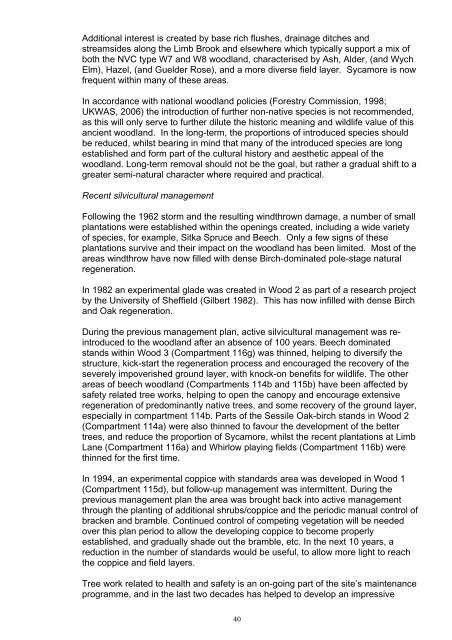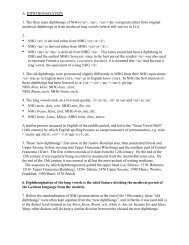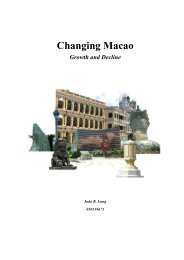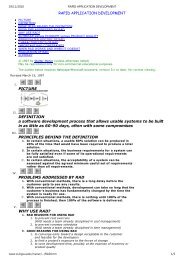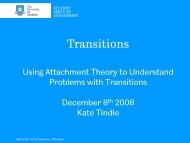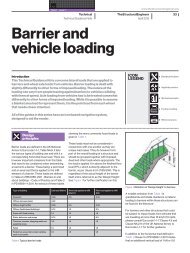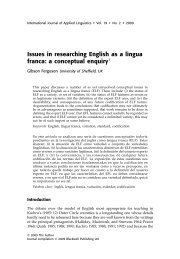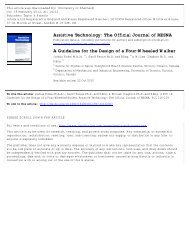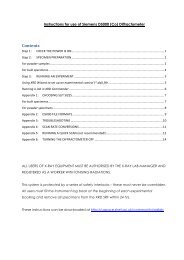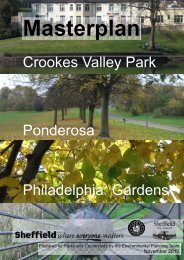eccelsall woods management plan.pdf - University of Sheffield
eccelsall woods management plan.pdf - University of Sheffield
eccelsall woods management plan.pdf - University of Sheffield
You also want an ePaper? Increase the reach of your titles
YUMPU automatically turns print PDFs into web optimized ePapers that Google loves.
Additional interest is created by base rich flushes, drainage ditches and<br />
streamsides along the Limb Brook and elsewhere which typically support a mix <strong>of</strong><br />
both the NVC type W7 and W8 woodland, characterised by Ash, Alder, (and Wych<br />
Elm), Hazel, (and Guelder Rose), and a more diverse field layer. Sycamore is now<br />
frequent within many <strong>of</strong> these areas.<br />
In accordance with national woodland policies (Forestry Commission, 1998;<br />
UKWAS, 2006) the introduction <strong>of</strong> further non-native species is not recommended,<br />
as this will only serve to further dilute the historic meaning and wildlife value <strong>of</strong> this<br />
ancient woodland. In the long-term, the proportions <strong>of</strong> introduced species should<br />
be reduced, whilst bearing in mind that many <strong>of</strong> the introduced species are long<br />
established and form part <strong>of</strong> the cultural history and aesthetic appeal <strong>of</strong> the<br />
woodland. Long-term removal should not be the goal, but rather a gradual shift to a<br />
greater semi-natural character where required and practical.<br />
Recent silvicultural <strong>management</strong><br />
Following the 1962 storm and the resulting windthrown damage, a number <strong>of</strong> small<br />
<strong>plan</strong>tations were established within the openings created, including a wide variety<br />
<strong>of</strong> species, for example, Sitka Spruce and Beech. Only a few signs <strong>of</strong> these<br />
<strong>plan</strong>tations survive and their impact on the woodland has been limited. Most <strong>of</strong> the<br />
areas windthrow have now filled with dense Birch-dominated pole-stage natural<br />
regeneration.<br />
In 1982 an experimental glade was created in Wood 2 as part <strong>of</strong> a research project<br />
by the <strong>University</strong> <strong>of</strong> <strong>Sheffield</strong> (Gilbert 1982). This has now infilled with dense Birch<br />
and Oak regeneration.<br />
During the previous <strong>management</strong> <strong>plan</strong>, active silvicultural <strong>management</strong> was reintroduced<br />
to the woodland after an absence <strong>of</strong> 100 years. Beech dominated<br />
stands within Wood 3 (Compartment 116g) was thinned, helping to diversify the<br />
structure, kick-start the regeneration process and encouraged the recovery <strong>of</strong> the<br />
severely impoverished ground layer, with knock-on benefits for wildlife. The other<br />
areas <strong>of</strong> beech woodland (Compartments 114b and 115b) have been affected by<br />
safety related tree works, helping to open the canopy and encourage extensive<br />
regeneration <strong>of</strong> predominantly native trees, and some recovery <strong>of</strong> the ground layer,<br />
especially in compartment 114b. Parts <strong>of</strong> the Sessile Oak-birch stands in Wood 2<br />
(Compartment 114a) were also thinned to favour the development <strong>of</strong> the better<br />
trees, and reduce the proportion <strong>of</strong> Sycamore, whilst the recent <strong>plan</strong>tations at Limb<br />
Lane (Compartment 116a) and Whirlow playing fields (Compartment 116b) were<br />
thinned for the first time.<br />
In 1994, an experimental coppice with standards area was developed in Wood 1<br />
(Compartment 115d), but follow-up <strong>management</strong> was intermittent. During the<br />
previous <strong>management</strong> <strong>plan</strong> the area was brought back into active <strong>management</strong><br />
through the <strong>plan</strong>ting <strong>of</strong> additional shrubs/coppice and the periodic manual control <strong>of</strong><br />
bracken and bramble. Continued control <strong>of</strong> competing vegetation will be needed<br />
over this <strong>plan</strong> period to allow the developing coppice to become properly<br />
established, and gradually shade out the bramble, etc. In the next 10 years, a<br />
reduction in the number <strong>of</strong> standards would be useful, to allow more light to reach<br />
the coppice and field layers.<br />
Tree work related to health and safety is an on-going part <strong>of</strong> the site’s maintenance<br />
programme, and in the last two decades has helped to develop an impressive<br />
40


